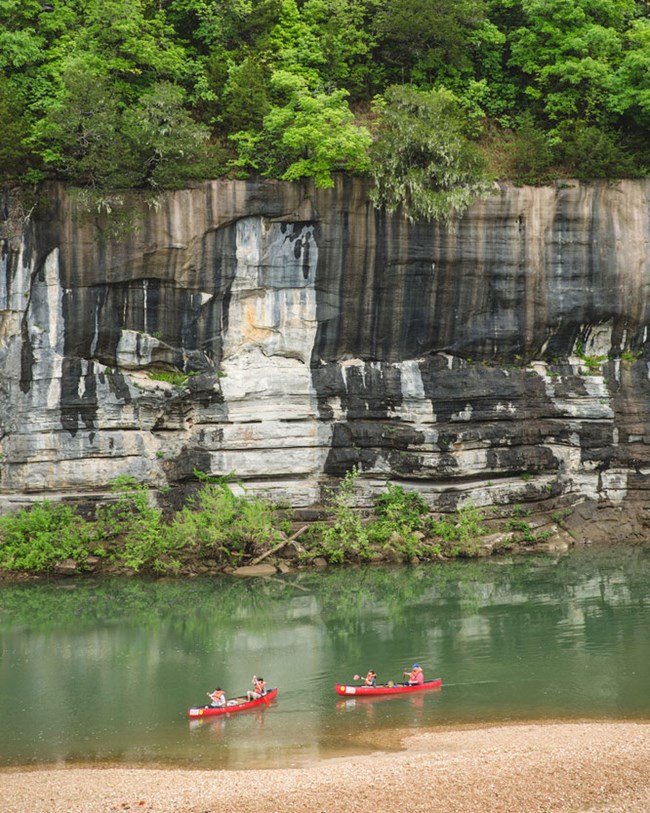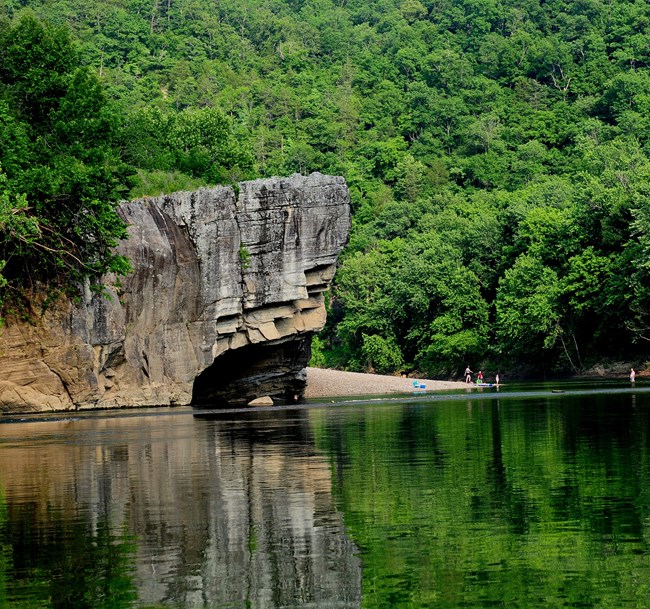Last updated: June 17, 2024
Article
NPS Geodiversity Atlas—Buffalo National River, Arkansas
Geodiversity refers to the full variety of natural geologic (rocks, minerals, sediments, fossils, landforms, and physical processes) and soil resources and processes that occur in the park. A product of the Geologic Resources Inventory, the NPS Geodiversity Atlas delivers information in support of education, Geoconservation, and integrated management of living (biotic) and non-living (abiotic) components of the ecosystem.

Introduction
Buffalo National River (BUFF), the country’s first designated national river, protects a 217 km (135 mi)-long stretch of the Buffalo River in Baxter, Marion, Newton, and Searcy Counties, Arkansas. Authorized on March 1, 1972, BUFF contains approximately 38,159 hectares (94,293 acres) and was established to preserve the free-flowing Buffalo River corridor as it winds though the Ozark Mountains (National Park Service 2016a, 2018). The landscape of BUFF is characterized by deep valleys, towering river bluffs, waterfalls, canyons, caves, sinkholes, sinking streams, springs, and historic sites. With more than 500 caves within its boundaries, BUFF is one of the most karst-rich units in the National Park System. The dense array of karst features in BUFF formed through a complex interplay of groundwater and surface water dissolution of underlying bedrock combined with pre-existing fractures that serve as conduits for subsurface water mobility. The topographic variability and geography of BUFF form a distinctive ecological setting that sustains critical habitats of high biological diversity and includes many rare species (National Park Service 2018).
Geologic Setting
Situated in the Ozark Plateaus physiographic province in northern Arkansas, the bedrock geology of BUFF consists of Paleozoic sedimentary rocks deposited from the Ordovician through the Pennsylvanian (Haley et al. 1993). Slow incision by the Buffalo River has produced a scenic canyon landscape with sheer sandstone bluffs and waterfalls. The notable karst landscape of the national river developed due to the presence of numerous fault structures combined with a thick sequence of Ordovician carbonate rocks that includes the Fernvale Limestone, Powell Dolomite, Cotter Dolomite, Plattin Limestone, and Kimmswick Limestone. The structural framework of BUFF contains numerous fault systems, grabens, folds, and dome features that have fractured the bedrock and enhanced groundwater dissolution in the subsurface, creating the many sinkholes, sinking streams, and caves in the national river. Young, surficial geologic units mapped within BUFF consist of Quaternary alluvial terrace deposits, channel deposits, and colluvium associated with the Buffalo River and its tributaries.
Regional Geology
Buffalo National River is a part of the Ozark Plateaus Physiographic Province and shares its geologic history and some characteristic geologic formations with a region that extends well beyond park boundaries.
- Scoping summaries are records of scoping meetings where NPS staff and local geologists determined the park’s geologic mapping plan and what content should be included in the report.
- Digital geologic maps include files for viewing in GIS software, a guide to using the data, and a document with ancillary map information. Newer products also include data viewable in Google Earth and online map services.
- Reports use the maps to discuss the park’s setting and significance, notable geologic features and processes, geologic resource management issues, and geologic history.
- Posters are a static view of the GIS data in PDF format. Newer posters include aerial imagery or shaded relief and other park information. They are also included with the reports.
- Projects list basic information about the program and all products available for a park.
Source: NPS DataStore Saved Search 2731. To search for additional information, visit the NPS DataStore.
A NPS Soil Resources Inventory project has been completed for Buffalo National River and can be found on the NPS Data Store.
Source: NPS DataStore Saved Search 2779. To search for additional information, visit the NPS DataStore.

